An Introduction to Process Art (Or, How Minimalism Went From Pretty to Gritty)

The common refrain, “It’s the journey, not the destination,” could make a perfect catchphrase for Process Art. A movement that arose in the 1960s and ’70s and has since expanded in definition to describe a general philosophical approach to making art, Process Art places its emphasis on the process and act of artistic creation rather than the […]



















